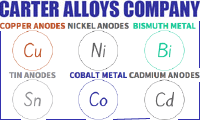
-----
Downside to Nickel S-Rounds in a Wood's Nickel Strike
The Wood's nickel strike used here has Nickel S-rounds in titanium baskets. The bath composition is about 8 oz Ni metal/gal (~33 oz NiCl2/gal) and about 15% v/v HCl. Two issues - the sulfur build-up in the strike bath has reached such levels that there is a distinct hydrogen sulfide odor and likely as a consequence we are experiencing a high incidence of nickel to stainless peel. Predominantly parts are plated in barrels and this tends to limit applied current density which may be an issue with the nickel to stainless peel because we presently process at 7 asf although some success has ben had re-working parts at higher asf (15 asf).
Is there any evidence to suggest that sulfur (and Nickel S-rounds) is detrimental to a Wood's strike?
plating shop employee - Beverly Massachusetts USA
December 21, 2010
Cost is a major factor as the S-round will dissolve quite fast in the high HCl and will result in either dumping or bleed & feed which is expensive with the cost on nickel, not to mention an unnecessary waste of materials.
Years ago, I read an article that stated that the high sulfur content did affect the strike. I do not remember where and most of my literature has been sold or given away.
I do remember having a graph of current density vs adhesion and it rose steadily to about 95 ASF, rounded off at 100 ASF and then fell like a rock. That literature probably came from INCO or the Nickel Institute. I got it from AK, who is no longer in business.
Before I got smart and went to rolled depolarized anodes, I found that carbon treatment helped with both the smell and the peeling. (For a while)
If you can not find rolled depolarized (I had only 1 source and they sold out to someone), try electrolytic chips. Titanium baskets are attacked in high HCl and high voltage, so watch your baskets.
I worked on nothing but SS with the Woods Nickel and found that using the high end of the acid and the low end of the nickel really helped. As I remember, there were three common sets of ranges. I think that I was using the middle one.
- Navarre, Florida
First of two simultaneous responses -- December 22, 2010
The main problem is that the S-rounds dissolve too fast and increase the metal content which convert a low efficiency "strike" into a high efficiency "plating solution", the opposite of what you want to do. Use Rolled Depolarized Nickel Anodes, and clean the sludge out more often. Take the anodes out over the weekend or when not in use.

Robert H Probert
Robert H Probert Technical Services
Garner, North Carolina

Second of two simultaneous responses -- December 22, 2010
adv.: Supplier of Copper Anodes, Nickel Anodes, Bismuth Metal, & Other Metal Products for Industry & The Arts

Q, A, or Comment on THIS thread -or- Start a NEW Thread